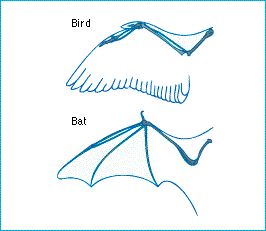The evidence for evolution - What do homologous similarities tell us?

Homologous similarities between species
The argument for evolution does not have to rely on small scale observations: homologous similarities provide powerful evidence for evolution.
If we take any two living species, they will show some similarities in appearance. Here, we need to distinguish two sorts of similarity: homologous and homoplasious similarity. (In this tutorial, these terms have a non-evolutionary meaning, which was common before Darwin. They should not be confused with the evolutionary meanings.)
A homoplasious similarity is one that can be explained by a shared way of life. The wings of birds and bats have developed separately: this can be explained by their similar functional requirements.
Homologous similarities between species cannot be explained by functional needs. The pentadactyl (five-digit) limb of tetrapods is a classic example.
Figure: the wings of birds and bats are homoplasies. They are structurally different: the bird wing is supported by digit number 2, the bat wing by digits 2-5.
| Next |



